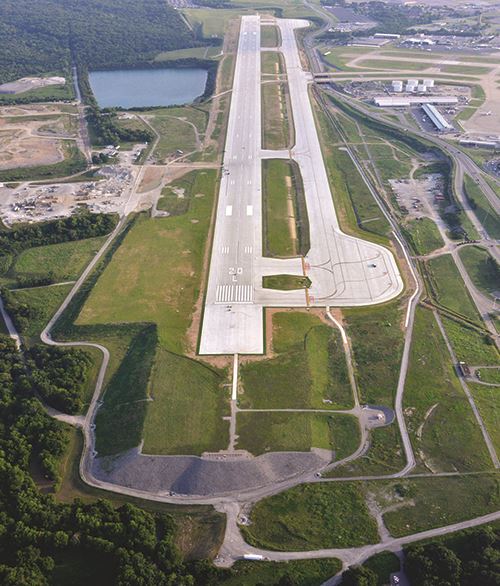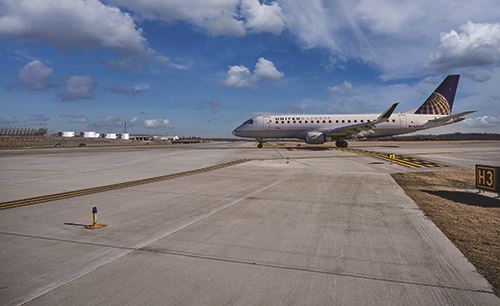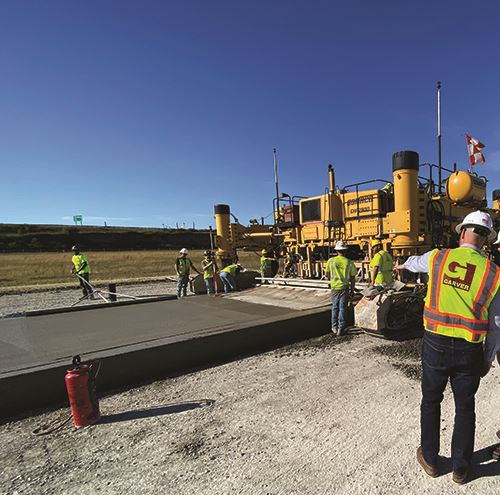Some say it isn’t easy being green, but Nashville International Airport (BNA) certainly makes it look effortless. When the Music City airport opened Concourse D in 2020, the project achieved LEED Silver certification for a sustainable, wellness-oriented design and construction process. It is one of just nine airport facilities in the world to earn LEED Silver under the U.S. Green Building Council’s v4 standards.
Some say it isn’t easy being green, but Nashville International Airport (BNA) certainly makes it look effortless.
When the Music City airport opened Concourse D in 2020, the project achieved LEED Silver certification for a sustainable, wellness-oriented design and construction process. It is one of just nine airport facilities in the world to earn LEED Silver under the U.S. Green Building Council’s v4 standards.
In 2017, the Water Source Geothermal project at BNA netted an Envision Silver award from the Institute for Sustainable Infrastructure. Metropolitan Nashville Airport Authority received the honor for its efforts to promote water conservation, energy efficiency, social well-being and community involvement.
|
Project: Runway Reconstruction Location: Nashville Int’l Airport Owner: Metropolitan Nashville Airport Authority Runway: 2R-20L Approx. Cost: $56.6 million Funding: Airport Improvement Program Construction: 2018-Aug. 2021 Project Lead: Garver Geometric, Grading & Drainage Design: Atkins North America Erosion/Sediment Control Plans, Stormwater Pollution, Airfield Markings: Shrewsberry Pavement Design: RDM Int’l Topographical Survey: Civil Infrastructure Associates Geotechnical Investigations/Environmental: Wood Environment & Infrastructure Solutions Project Documentation: TRTH Consulting Concrete Paving: Hi-Way Paving Concrete Recycling: Antigo Construction Earthwork and Drainage: Eutaw Construction Electrical, Lighting & Signage: BBH Electric Noise Modeling: HMMH Of Note: Runway was originally constructed over quarry with deep fill, which made settlement a concern. Recycling concrete into aggregate base on site shaved up to 11% of project cost & supported airport’s sustainability goals |
Most recently, BNA received an Honor Award in the ACEC Engineering Excellence Award competition for the sustainability and unique engineering of its Runway 2R-20L reconstruction project. Here, the airport shaved an estimated $6.4 million off construction costs by using recycled concrete aggregate for the base of its 8,000-foot main runway.
“Sustainability is a key initiative for the airport. We try to be as sustainable as we can on every project,” says Traci Holton, BNA vice president, chief engineer and deputy chief operating officer. “For this project, we recycled all of the concrete.”
Antigo Construction broke up the existing 15-inch pavement on Runway 2R-20L and rubblized it to use during reconstruction. Material not needed for the new runway was saved for other projects in the airport’s $1.6 billion Vision program.
“It’s hard to put a hard number on total savings, because we saved some recycled concrete for other projects,” says Holton. “But using off-site materials can be up to four times the cost. The savings are pretty significant any time you can use materials in place.”
Personnel from Garver, the engineering, planning, architectural and environmental services firm that lead the project, are similarly enthusiastic about the recycling method. Ryan Sisemore, vice president for Garver, stresses that the 50,000 cubic yards of processed material left over from the runway project will save BNA money in the future.
“We flipped the script,” he remarks. “We went from looking at concrete removal as a liability, to viewing it as an asset. Before, we would have hauled the material away for disposal. Instead, it’s in a stockpile to use in future projects, saving future dollars.”
According to Sisemore, the price for virgin crushed aggregate base averages $45 a ton, but the airport’s cost for recycled concrete aggregate came in at $13.50 a ton.
Pavement in Need
Runway 2R-20L was constructed in 1989 and reached the end of its useful life in 2018. It had received multiple rehabs and isolated repairs throughout the years, but complete replacement became the only option when its Pavement Condition Index (PCI) dropped from 70 to 54.
“The poor rating didn’t mean the runway was unsafe,” Holton specifies, “but it showed it was time for reconstruction.”
When the airport issued a request for qualifications, Sisemore knew he wanted to win the work. “It was an interesting job, and a huge opportunity for sustainable construction,” he explains.
Garver had previously completed dozens of projects at BNA, but Sisemore was particularly drawn to this one because the original runway was built on a former rock quarry—a 350-foot-deep depression that had required substantial fill. The fill had slowly settled over the years, requiring crews to pressure grout and replace entire concrete slabs to restore the runway’s profile.
“With deep fill, there’s always slow settlement that occurs,” Sisemore explains. “They had to fix the runway a couple times to lift it up. We knew going in that we would need a solid structural plan for runway replacement.”
Earlier, BNA had also converted the remaining rock quarry lake, which sits next to the runway, into a vast geothermal cooling system. Submerged lakes plates cool water, which makes a continuous loop to and from a terminal’s central utility plant. The 2-mile-long pipeline that crosses the runway and taxiway needed preservation during the recent runway reconstruction.

Complex Calculations
Sisemore quickly assembled a team to assist with the complex project. Garver first engaged Wood Environment & Infrastructure Solutions to assess concerns about continued settlement over the quarry.
Wood performed subsurface exploration, laboratory testing, fill embankment settlement assessments and stability assessments. After analyzing the effectiveness of previous stabilization efforts, the firm developed a new strategy for mitigating settlement to optimize pavement performance for the runway. Later in the project, Wood examined blasting plans during rock excavation.
 “We completed deep bores and found most settlement had stopped,” Sisemore reports.
“We completed deep bores and found most settlement had stopped,” Sisemore reports.
But they also learned more about deep fills. For instance, the slightest earth movement over time rounds the angular edges of deep fill and causes settlement. Additionally, as limestone weathers, it becomes softer with similar degradation, continuing consolidation.
To ensure that the airfield was ready for such settlement, the project team combined multiple stabilization techniques to mitigate consolidation in the new runway. The key strategy was the elimination of as much top-down water entering the fill as possible.
“The reconstruction process in and of itself created a lot of fines at the top of the subgrade to fill voids and choke off the ability to drain water. Then we added an edge drain system to collect and convey that water away from the pavements,” Sisemore explains. “The contractor sealed that off well before placing new concrete. Then, we strengthened the concrete with additional reinforcing and both longitudinal and transverse dowel bars for added support.”

Reclamation for Replacement
Using reclaimed asphalt pavement for new construction has been a popular practice in the roadway industry for years. However, the FAA has moved more slowly to approve the process for runways and other key airfield pavements. “The No. 1 goal is always safety, so adopting new construction practices takes time,” Sisemore explains. “Over the last decade, airports have increasingly used reclaimed asphalt as aggregate for new pavements. We still must use virgin aggregates in the top layer concrete, but below that we can use recycled aggregate.”
At BNA, tests performed by the Garver team determined that the existing concrete on Runway 2R-20L was durable enough for reuse and would achieve required FAA gradations. Antigo subsequently broke up the concrete and hauled it to an onsite plant for rubblizing. Crews operated three to four guillotine breakers for 17 days to remove the old concrete, and then used an MHB breaker for three days to rubblize it. Processing the material took almost a full month and involved two stages of crushing—first with jaw crushers, then with impact crushers to remove contaminants and screening.
Aggregating the concrete provided enough base course and stabilized base for the entire runway reconstruction project, plus material to spare. The airport plans to use the remaining fill for a ramp expansion that is slated to begin next year.
Noise and Efficiency
When rebuilding its busy main runway, BNA temporarily shifted all traffic to the airfield’s other three runways. This, however, resulted in more flights over nearby residential neighborhoods. And being a good neighbor is important to the airport, Holton notes.
Garver brought in HMMH to model noise levels, then submitted its findings to the FAA. The airport responded by shifting heavy operations to the west-most runway and moving other traffic to the center runway to keep noise under control.
“Airfield Operations did a wonderful job of analyzing how they wanted to reconfigure airfield use during the 18 months of construction,” Sisemore says. “As a result, the airlines didn’t overly suffer from long taxi routes.”
Garver brought in Atkins North America to help improve the efficiency of the runway and taxiway exits. “The project faced a significant geometrical challenge in that it was necessary to remove the current high-speed taxiway exits that were not supported by current FAA standards,” Sisemore explains. “Because of the operational density and runway to taxiway separation, the next connector taxiways had to be perpendicular.”

Atkins examined multiple potential solutions and ultimately selected locations for Taxiway H3 and H4 (the primary runway exits from each direction) because they balanced the time an arriving aircraft occupied the runway with capture ratios.
Atkins also corrected the runway profile to meet FAA requirements by shifting the north vertical curve outside the end quarter of the runway and thereby lifting a portion of the runway by as much as 2.5 feet. Sisemore cited Dave Schilling and Jennifer Casterline of Atkins as key contributors throughout the course of design and construction.
Focus on the Future
During the runway reconstruction project, crews installed redundant piping underneath the runway and taxiway for the airport’s geothermal cooling system by adding two new 36-inch steel casing pipes. This will allow an expansion on the current geothermal system that cools nearly a million square feet of terminal space.
 “We decided not to expand the geothermal system with this project, but rather to put ourselves in a better position for that in the future,” Holton explains, noting that the strategy demonstrates BNA’s focus on resilience.
“We decided not to expand the geothermal system with this project, but rather to put ourselves in a better position for that in the future,” Holton explains, noting that the strategy demonstrates BNA’s focus on resilience.
“The airport invested today’s dollars to install this corridor so they can expand without affecting the runway or parallel taxiway,” adds Sisemore. “All the needed infrastructure to cross the airfield is now in place.”
The airport also seized an opportunity to improve its electrical resilience. Previously, a single electrical feed supplied the terminal, but BNA added a second utility corridor across the airfield while reconstructing the main runway.
Holton explains that Nashville Electric Service previously had two independent feeds coming into BNA. However, those feeds came to a common point, and then fed electricity into the terminal building. “We now have two geographically separated redundant power feeds for greater electrical reliability,” she says.
Just as airport leaders incorporated resilience and sustainability elements into the recent runway reconstruction project, they will fold them into future phases of the BNA Vision program. Future plans include a new garage complex, concourse, international arrivals facility and additional airline gates.


 facts&figures
facts&figures

